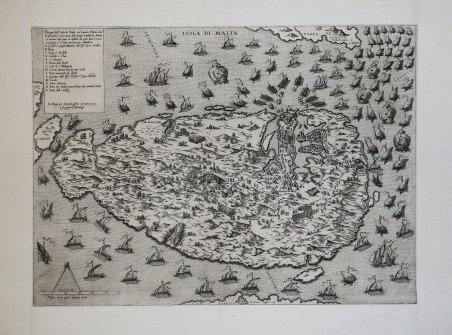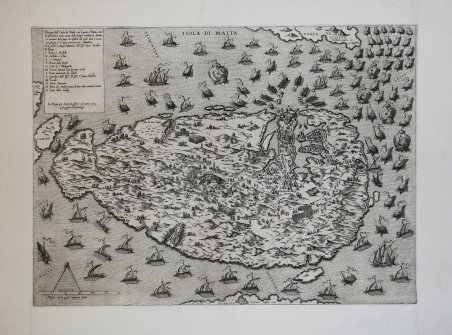Acquaforte e bulino, 1565, firmata e datata in lastra nel cartiglio.Esemplare nel rarissimo secondo stato di tre. Magnifica prova, impressa su carta vergata coeva con filigrana aquila nel cerchio con corona (Woodward 55), rifilata al rame e con margini coevi aggiunti, in perfetto stato di conservazione. Magnifica mappa dellisola di Malta, raffigurata durante lassedio dellarmata Turca del giugno 1565. Lisola è interamente circondata da una flotta navale, e nel porto di Valletta sono disegnate le scene di guerra. La mappa è un secondo stato della lastra anonima, ma attribuita alla bottega di Lafrery, sempre edito nel giugno del 1565. La differenza è nel titolo e nel nome delleditore aggiunto, e soprattutto nellaggiunta del campo dassedio delle truppe turche, posto nella parte meridionale di Valletta. Lopera ebbe una terza stesura, postuma, a cura di Pietro De Nobili, probabilmente per motivi commerciali data la bellezza della carta. Ganado suggerisce quale incisore della lastra Nicola Beatrizet, francese attivo a Roma.Magnifico esemplare.Le vicende dellisola di Malta, della costruzione della città fortificata, la guerra contro i Turchi e il celebre assedio dellisola costituiscono motivo di grande interesse nella civiltà rinascimentale europea, tanto da produrre una relativa cospicua letteratura e soprattutto una notevole produzione iconografica del susseguirsi degli eventi. Il Grande Assedio di Malta del 1565 rappresenta una pietra miliare nella storia delle isole maltesi, e anche un punto di svolta nella guerra tra i cristiani contro le forze dell'Impero Ottomano, conclusa con la celebre battaglia di Lepanto nel 1571. Nonostante queste due sconfitte catastrofiche, i Turchi continuarono a fare incursioni lungo le coste del Mediterraneo occidentale per il resto del secolo, dopo aver recuperato Cipro dai Veneziani e Tunisi dagli Spagnoli, ma il declino del loro impero era ormai annunciato. L'Assedio di Malta, che durò da maggio a settembre 1565, fu seguito con trepidazione non solo a Napoli, Roma e Venezia, ma anche a Vienna, Londra e Madrid, a Parigi, Anversa e Bruxelles. La notizia della lentezza degli assedianti e della disperata difesa dell'isola raggiunse la Sicilia attraverso le lettere scritte dal Gran Maestro Jean de La Valette- Parisot, bozzetti di battaglie spediti dai Cavalieri dell'Ordine di San Giovanni e Relationi, scritte da soldati o marinai. Scene e mappe dellassedio furono realizzate in Francia, Germania, Spagna e Italia per raccontare in immagini le diverse fasi della strenua resistenza di Malta contro le forze armate della Mezzaluna. In Italia i principali centri di produzione furono Roma e Venezia. Dato la finalità essenzialmente informativa di questi lavori, gli acquirenti non sempre si curavano della loro conservazione, ragione per cui sono oggi di incredibile rarità. Albert Ganado, il maggiore esperto di cartografia maltese, elenca oltre 60 lavori cartografici sullisola, nelle loro varie diverse ristampe, concentrati nel brevissimo spazio di soli 10 anni. Etching and engraving, 1565, signed and dated in the plate. Exemple in the rare second state of three. Magnificent proof, printed on contemporary laid paper with watermark "eagle in circle with crown" (Woodward 55), trimmed to the copperplate and with margins added, in a perfect state of preservation. Magnificent map of the island of Malta, represented the Turkish army during the siege in June 1565. The island is entirely surrounded by a naval fleet, and in the port of Valletta are drawn scenes of war. The map is a second state of the plate anonymous, but attributed to the workshop of Lafrery, also published in June 1565. The difference is in the title and name of the publisher added, and especially the addition of the field siege of the Turkish troops, located in the southern part of Valletta. The opera had a third issue, posthumously, edited by Pietro De 'Nobili, probably for commercial reasons given the beauty of the work. Ganado suggests as engraver of the plate Nicola Beatrizet, French, active in Rome.The history of the island of Malta, the construction of the walled city, the war against the Turks and the famous siege of the island, is a matter of great interest in European Renaissance culture, so as to produce a relatively large literature and above all a remarkable iconographic production of sequence of events. The year 1565 is a landmark in the history of the Maltese Islands. It was also a turning-point in the struggle of Christendom against the forces of the Ottoman Empire, on which the battle of Lepanto (1571) put the final seal. Despite these two disasters, the Turks continued to ravage the coasts of the western Mediterranean during the rest of the century, after having recovered Cyprus from the Venetians and Tunis from the Spaniards; but the decline of their empire was in sight. The siege of Malta, which lasted from May till September 1565, was watched with trepidation not only in Naples, Rome and Venice, but even in Vienna, London and Madrid, in Paris, Antwerp and Brussels. News of the slow progress of the besiegers and of the desperate defence of the island reached Sicily through letters written by Grand Master La Valette, battle-sketches despatched by the Knights of the Order of St. John and Relationi written by soldiers or seamen. Thence it spread fanlike to all the centers of Christendom stretching from the Iberian peninsula in the west to Hungary in the east. Picture-maps of the siege were produced in France, Germany, Spain and Italy to illustrate for the layman the stand being put up by Catholic Malta against the armed might of the Crescent, the main centers of production being Rome and Venice, which even turned out several editions of various broadsheets to bring up to date the latest developments in the bitter and uneven struggle. Albert Ganado, the major expert of Maltese cartography, clists over 60 maps on the island, in their various states, concentrated in a very short space of just 10 years.


Find out how to use
Find out how to use

